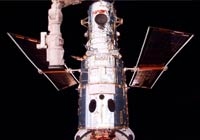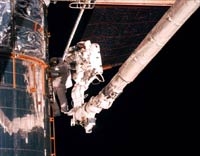Servicing Mission 2
The Second Servicing Mission (STS-82) took place in February 1997. The primary goal of the Second Servicing Mission was the replacement of two first generation Scientific Instruments (FOS and GHRS) with two new ones (NICMOS and STIS). A number of other servicing tasks were also performed. Altogether five spacewalks were performed during the mission.
 |
 |
|
Hubble after capture with the remote manipulator arm. Ready for surgery! |
Astronauts Lee and Smith repairing parts of Hubble's insulation. |
What was done
- The Faint Object Spectrograph (FOS) was removed.
- The state-of-the-art Near Infrared Camera and Multi-Object Spectrometer (NICMOS) was installed. This looks at the universe at near infrared wavelengths with a higher sensitivity than any other existing or planned telescope. NICMOS is both a camera and a spectrometer.
- The Goddard High Resolution Spectrograph (GHRS) was removed.
- The Space Telescope Imaging Spectrograph (STIS) was installed. STIS is sensitive to light in ultraviolet wavelengths and employs two-dimensional detectors that allow the instrument to gather 30 times more spectral data than the first-generation Hubble spectrographs. STIS is considered to be the most complex scientific instrument built for space science.
- Astronauts replaced one of the three Fine Guidance Sensors, which keep the telescope still and in position so that the science instruments can record unblurred images.
- A Tape Recorder was installed. This stores up to one billion bits of science and engineering data that cannot be transmitted to the ground in real time.
- A Data Interface Unit was replaced. This receives and sends commands and data requests.
- New Magnetic Sensing System Covers were installed. They cover the device that measures the telescope's orientation relative to the Earth's magnetic field.
- An Optical Control Electronics Enhancement Kit was installed. This is used to adjust the Fine Guidance Sensors (FGS), which keep the telescope still and in position so that the science instruments record unblurred images.
- One of the four Reaction Wheel Assemblies was replaced. This is a set of wheels that moves the telescope from one target to another.
- One of the two sets of Solar Array Drive Electronics was replaced. This is modular hardware that controls the position of the solar arrays.
- A new type of Solid State Recorder was installed. This is a state-of-the-art digital recorder that replaces one of Hubble's reel-to-reel recorders. It is important because it stores much more data.
- Several tears in Hubble's insulation material were repaired with a mixed assortment of unconventional spacewalking tools: parachute cord, Teflon insulation with holders made of Velcro, Teflon-coated copper wire, electrical tie wraps, and plastic tie wraps.
Last Update: 1 September 2019
